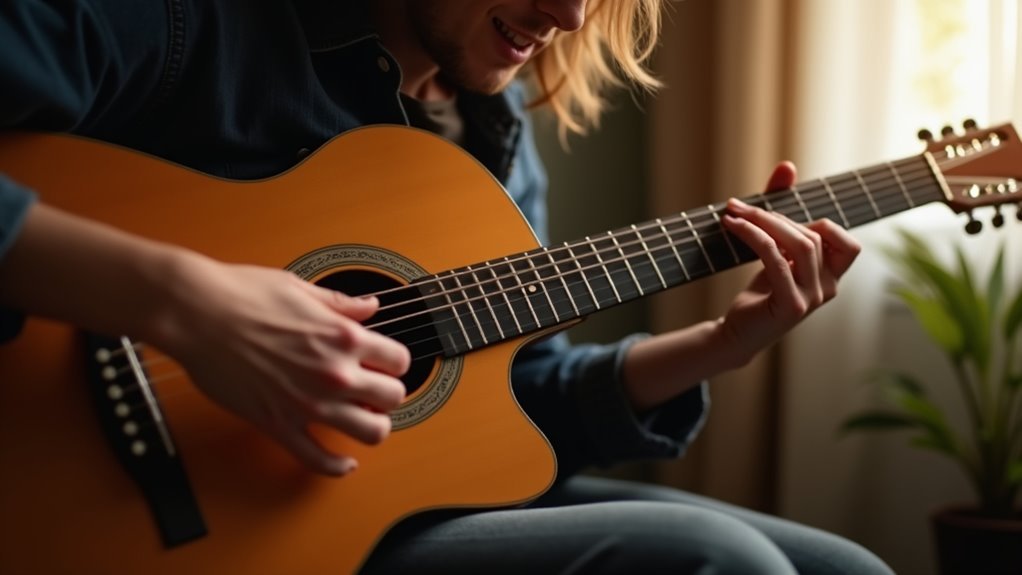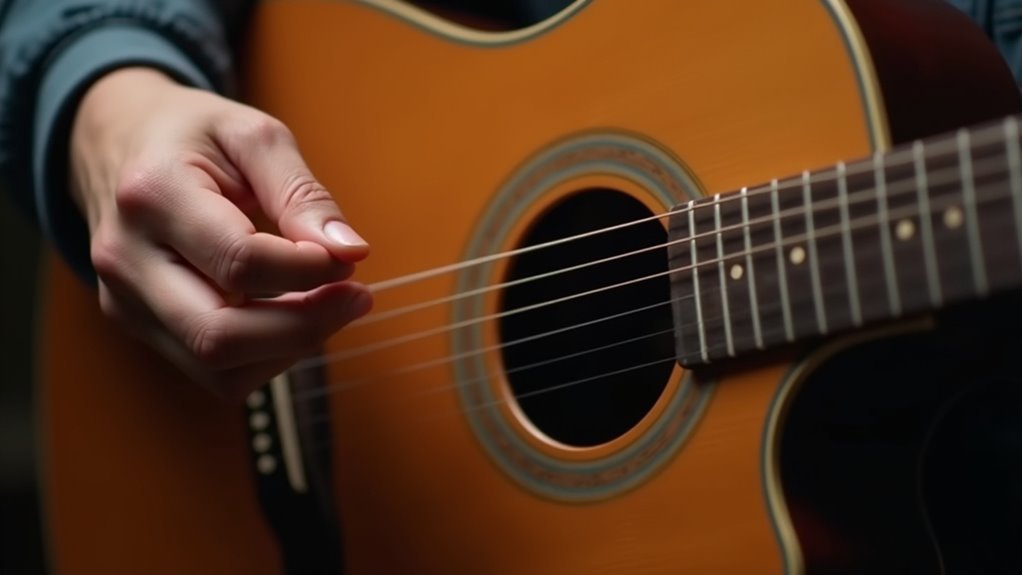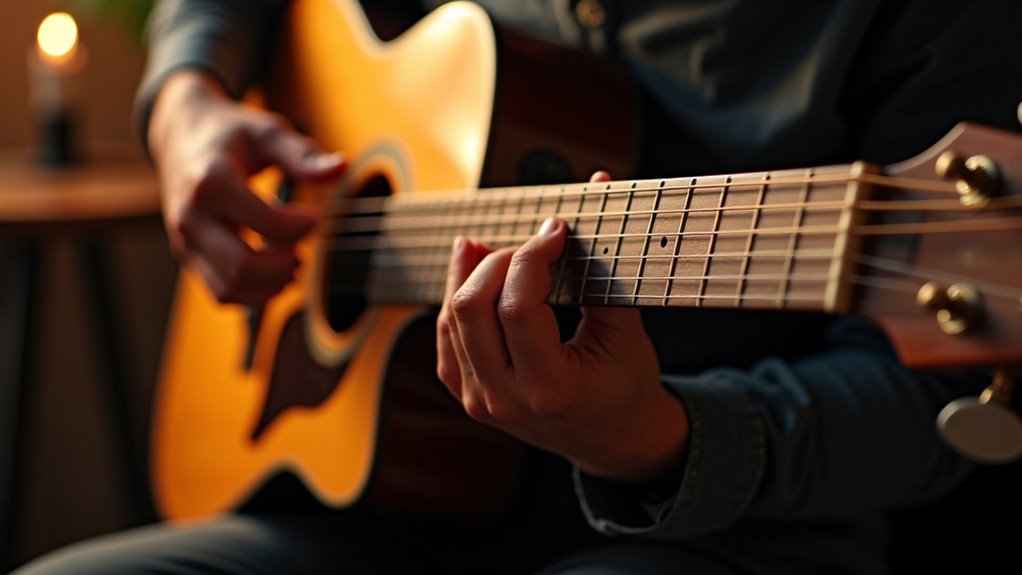Sarah mastered “Dust in the Wind” in just three weeks after overhauling her fingerstyle technique. We’ll show you how to achieve similar results by breaking down the essential components of fingerstyle guitar. From proper hand positioning to advanced picking patterns, we’ve distilled decades of teaching experience into a step-by-step system that works. Let’s transform your fingerpicking from hesitant plucking to confident, fluid expression.
Mastering Basic Fingerstyle Techniques

When diving into fingerstyle guitar, proper hand positioning forms the foundation of everything that follows.
We’ll start with your picking hand – keep that wrist flat or slightly bent to avoid rest strokes and maintain control. Trust us, it’s essential.
Your thumb and three fingers are your primary tools here. Let’s build that muscle memory through simple finger picking patterns. Your index finger leads the charge, but don’t neglect alternate finger picking – it’s your secret weapon against fatigue.
Watch those fingernails. They should align perfectly with your fingertips for ideal string contact.
And here’s a pro tip: master the free stroke technique. When you pluck a string, your finger should float freely without touching adjacent strings. Clean sound, clean technique – that’s what we’re after.
Understanding Rest Stroke Vs Free Stroke Methods
The war between rest stroke and free stroke techniques divides many guitarists, but we’ll settle this debate right now. For fingerstyle guitar, free stroke emerges as the clear winner, delivering the articulate playing and smooth shifts we need.
- Rest stroke creates powerful sounds by landing on adjacent strings – great for flamenco, but it’ll mess up your fingerstyle arpeggios.
- Free stroke lets fingers move freely under your hand, perfect for clear note separation and fluid chord shifts.
- You’ll get better musicality and expression with free stroke’s unrestricted movement.
- When practicing fingerstyle pieces, stick exclusively to free stroke – it’s your ticket to refined, articulate playing.
Trust us on this: master free stroke first. It’s the foundation you need for serious fingerstyle guitar development.
Proper Hand Position and Movement

Now that you’ve got your free stroke technique down, let’s fix your hand position – it’s probably sabotaging your playing right now.
Keep your wrist flat or slightly bent, and position your hand neutrally above the strings. Trust me, this proper hand position eliminates those pesky lateral movements that wreck your accuracy.
Your plucking technique needs one critical adjustment: initiate movement from the knuckle, not the middle joint.
Let your fingertip swing toward your palm – it’s the difference between amateur and pro-level control. Strike strings at the perfect angle to avoid that awful twanging sound we all hate.
Build muscle memory through daily positioning exercises.
We’re not just practicing fingerstyle technique here – we’re programming your hands for peak performance. Your fingers should move like well-oiled machinery, not drunk spiders.
Essential Practice Strategies for Fingerpicking
Since mastering fingerpicking demands laser-focused practice, let’s break down the essential strategies you’ll need.
We’ll focus on developing your guitar playing through systematic, proven methods that build muscle memory and technical precision.
- Set your metronome slow and practice alternating between your thumb and three fingers, gradually increasing speed only when you’ve mastered clarity at slower tempos.
- Drill specific fingerstyle songs using index and middle fingers while maintaining strict rhythm – no shortcuts.
- Master individual picking patterns with a single chord before moving on, focusing on clean string separation.
- Dedicate time to structured practice sessions using online tutorials and instructional materials that match your skill level.
Developing Rhythm and Groove in Fingerstyle Playing

Creating hypnotic, immersive fingerstyle guitar requires more than just technical precision – it demands an unshakeable sense of rhythm and groove.
Let’s tackle this head-on with a metronome or drum beats as our trusty companions. They’re your secret weapons for developing rhythmic accuracy and maintaining that essential steady tempo.
Nothing builds rock-solid rhythm and timing like faithful practice with a metronome or drum track backing you up.
We’ll build your picking patterns through focused repetition, embedding them into muscle memory until they flow naturally.
Don’t just mindlessly practice – groove with purpose. Mix up your practice routine with different drum beats to expand your stylistic range.
Once you’ve mastered steady timing, we’ll explore intentional tempo variations to add emotional depth to your playing. Speed up during powerful sections, ease back for tender moments – these subtle changes transform good fingerstyle into great fingerstyle.
Building Speed and Dexterity Through Exercises
Building lightning-fast fingerstyle chops demands methodical, deliberate practice focused on speed and dexterity.
We’ll transform your fingers into precision instruments through targeted exercises that build both strength and control.
- Start with single-chord repetitive fingerpicking patterns at a snail’s pace – trust us, speed comes from slow, deliberate movements mastered first.
- Practice alternate picking religiously – it’s your ticket to enhanced finger coordination and stamina when the tempo cranks up.
- Drill each finger individually from the knuckle, focusing on clean, precise movements that’ll translate into fluid changes.
- Incorporate scale exercises using fingerstyle techniques, gradually increasing tempo as your muscle memory solidifies.
Remember: dexterity isn’t built overnight.
Your fingers need time to adapt to these new movement patterns.
Stay patient, stay focused, and keep practicing.
Creating Rich Sound Through Bass and Melody Balance

The rich tapestry of fingerstyle guitar emerges from a delicate dance between bass and melody lines. We’ll master this art by focusing on the balance between bass strings and melody notes, ensuring each element serves its purpose in creating a rich sound.
| Element | Function | Practice Tip |
|---|---|---|
| Bass Notes | Foundation | Pluck with authority |
| Melody | Lead Voice | Practice in isolation |
| Root Notes | Harmonic Context | Emphasize first beat |
| Pattern Control | Texture Building | Start slow, build speed |
Let’s tackle this systematically: pluck those bass strings with conviction, letting them resonate fully. Meanwhile, your melody notes should float above, crystal clear and precise. Experiment with different fingerpicking patterns to find your sweet spot, always maintaining that essential harmonic context. Remember: strong bass foundation + distinct melody = sonic magic.
Frequently Asked Questions
How to Improve Fingerpicking Technique?
Let’s start with basic fingerpicking patterns, focusing on thumb independence and proper finger positioning. We’ll establish daily practice routines while avoiding common mistakes like excessive hand movement.
What Is the Best Way to Learn Fingerstyle Guitar?
Let’s explore how online courses and practice routines build our skills. We’ll master proper hand positioning, start with simple fingerstyle songs, and progress naturally, whether using acoustic or electric guitars.
Why Is Fingerstyle so Difficult?
We find fingerstyle challenging because it demands finger independence and complex muscle memory. Common challenges include coordinating both hands while avoiding beginner mistakes, making consistent practice techniques essential for improvement.
How Many Fingers Should You Use for Fingerpicking?
We typically use four fingers for fingerpicking patterns: thumb plus three fingers (index, middle, ring). This finger positioning allows ideal hand coordination, thumb independence, and precise string selection while playing.